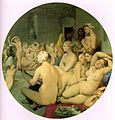| |
讓·奧古斯特·多米尼剋·安格爾(Jean Auguste Dominique Ingres,1780年8月29日-1867年1月14日)是法國畫傢,新古典主義畫派的最後一位領導人,他和浪漫主義畫派的傑出代表歐仁·德拉剋羅瓦之間的著名爭論震動了整個法國畫壇。
安格爾的畫風綫條工整,輪廓確切,色彩明晰,構圖嚴謹,對後來許多畫傢如德加、雷諾阿、甚至畢加索都有影響。
生平
安格爾出生於法國南部加竜河上遊的塔恩-加竜省首府蒙托邦,父親是一位肖像畫傢和音樂傢,是他的藝術啓蒙教師,1791年他入圖盧茲學院學習繪畫;1797年到巴黎進入古典主義畫派的主要代表人雅剋-路易·大衛的畫室;1799年考入美術學院油畫係;1801年獲一等羅馬奬;1806年到羅馬設畫室,創作了大量的作品;1820年遷到佛羅倫薩,接受了大批肖像畫的訂作;1824年回到巴黎,立即獲得很高榮譽;1825年被選為法蘭西學院院士;1829年任美術學院院長;1835年再次回到羅馬,創作了一係列肖像素描和油畫;1841年回巴黎,繼續創作多幅巨作。
安格爾一生最崇拜拉斐爾和古代大師,直到87歲高齡還在研究拉斐爾的作品,其最後一件作品就是根據喬托的構圖畫的。他的主要作品有《土耳其浴女》、《泉》、《路易十三世的宣誓》、《奧德利斯剋與奴隸》以及一係列肖像畫和大量的素描,還有類似中國畫白描的衹用綫描鈎輪廓的作品。
安格爾的聲譽如日中天時,也正是古典主義面臨終結,浪漫主義崛起的時代,他和新生的浪漫主義代表人德拉剋羅瓦之間發生許多次辯論,浪漫主義強調色彩的運用,古典主義則強調輪廓的完整和構圖的嚴謹,安格爾把持的美術學院對新生的各種畫風嗤之以鼻,形成學院派風格。
安格爾生前享有很大的聲譽,死後安葬在巴黎著名的拉雪茲神父公墓。
畫廊
Jean-Auguste-Dominique Ingres (/ˈæŋɡrə, ˈæ̃ɡrə/ ANG-grə, French: [ʒɑ̃ oɡyst dɔminik ɛ̃ɡʁ]; 29 August 1780 – 14 January 1867) was a French Neoclassical painter. Ingres was profoundly influenced by past artistic traditions and aspired to become the guardian of academic orthodoxy against the ascendant Romantic style. Although he considered himself a painter of history in the tradition of Nicolas Poussin and Jacques-Louis David, it is his portraits, both painted and drawn, that are recognized as his greatest legacy. His expressive distortions of form and space made him an important precursor of modern art, influencing Picasso, Matisse and other modernists.
Born into a modest family in Montauban, he travelled to Paris to study in the studio of David. In 1802 he made his Salon debut, and won the Prix de Rome for his painting The Ambassadors of Agamemnon in the tent of Achilles. By the time he departed in 1806 for his residency in Rome, his style—revealing his close study of Italian and Flemish Renaissance masters—was fully developed, and would change little for the rest of his life. While working in Rome and subsequently Florence from 1806 to 1824, he regularly sent paintings to the Paris Salon, where they were faulted by critics who found his style bizarre and archaic. He received few commissions during this period for the history paintings he aspired to paint, but was able to support himself and his wife as a portrait painter and draughtsman.
He was finally recognized at the Salon in 1824, when his Raphaelesque painting of the Vow of Louis XIII was met with acclaim, and Ingres was acknowledged as the leader of the Neoclassical school in France. Although the income from commissions for history paintings allowed him to paint fewer portraits, his Portrait of Monsieur Bertin marked his next popular success in 1833. The following year, his indignation at the harsh criticism of his ambitious composition The Martyrdom of Saint Symphorian caused him to return to Italy, where he assumed directorship of the French Academy in Rome in 1835. He returned to Paris for good in 1841. In his later years he painted new versions of many of his earlier compositions, a series of designs for stained glass windows, several important portraits of women, and The Turkish Bath, the last of his several Orientalist paintings of the female nude, which he finished at the age of 83.










